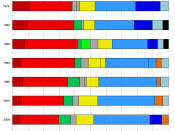By: Ferry van de Mosselaer
"It's our challenge - together, as allies and partners - to build the bridges to the next millennium, from the Danube to the Potomac, from the Black Sea to the Pacific Ocean and beyond, wherever people believe in and fight for freedom" [Romanian President Constantinescu, US Congress Session, July 1998. "Romania in the 21st Century: Challenges and Opportunities in an Evolving Trans-Atlantic Environment "]
Background
Christmas day 1989; Romania removes itself from its dictator Ceausescu and, in accordance to the rest of Eastern Europe, its Communist regime. This is the beginning of the so called 'transition period', the period in which Romania is going to transform its complete political structure into a democratic republic and its command economy into a market economy. From an almost fully state-owned economy, with the private sector only contributing 12.8% to the GDP in 1989, to an international orientated market economy in the spirit of the EU in 2007.
This capital slurping project for both sides (EU and Romania) has to be a beneficial investment. What could be the economic added-value of Romania to the EU and what impulse can the EU give to the Romanian economy?
Romanian development
The figures of the Romanian macro-economic development between 1989 and 1999 are not as progressive as, maybe, expected or they don't show the improvement they should have shown. Private sector contribution nevertheless increased significantly to 61.5% in 1999, still the state-owned companies play a dominant role in several sectors. Inflation rates have exaggerated with a 256.1% inflation rate in 1993 as a maximum. Unemployment increased from 3.0% in 1991 to 11.5% in 1999, although ILO (International Labour Organization) figures show a rate of 6.8% in 1999 and 7.1% in 2000. GDP growth rates were 6 out of 10 years negative with...


